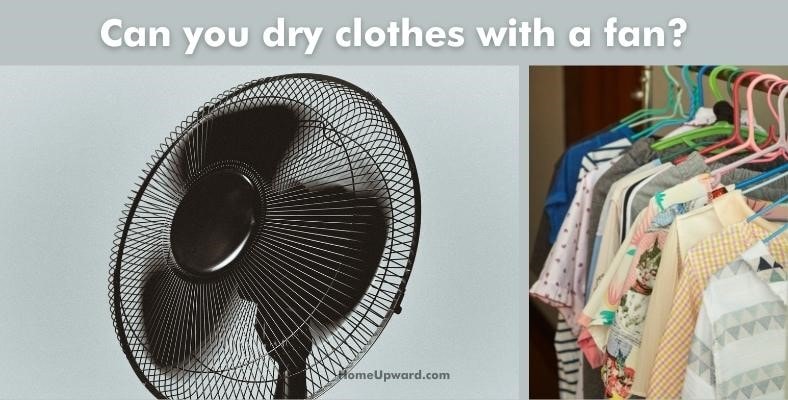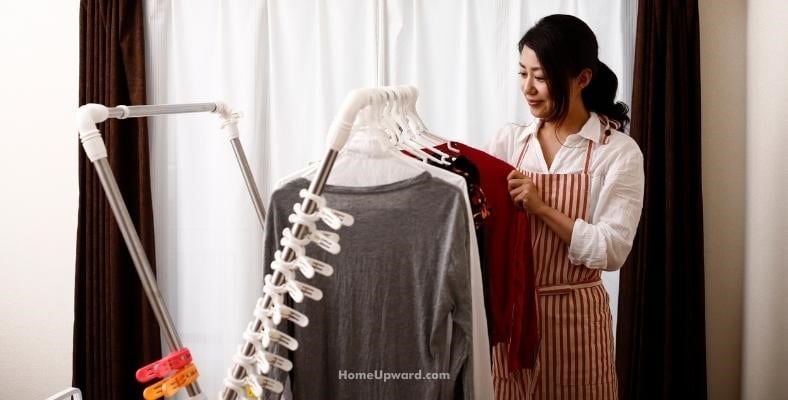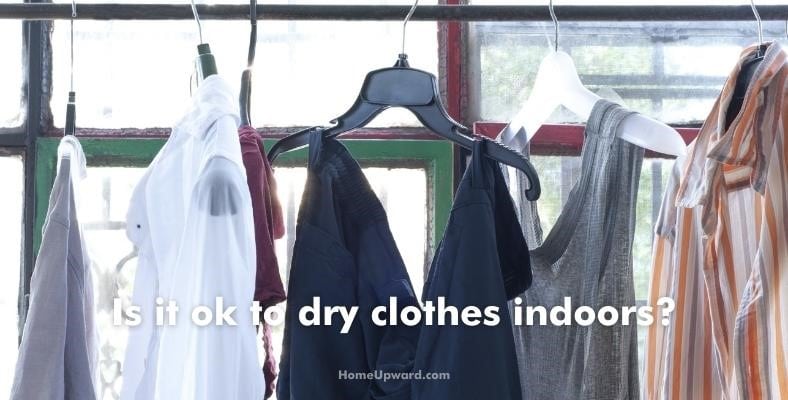It’s easy to learn how to dry clothes without owning a dryer at home and without spending money at a laundromat.
Here I’ll cover some handy ways to dry your clothes without a dryer – great if you want to save money on your energy bill, too!
Contents
How to Dry Clothes Without a Dryer
How Long Do Clothes Take To Air Dry?
Clothing can take anywhere from a couple of hours to an entire day to air-dry depending on the temperature and humidity levels.
- The thickness and fabric of the clothing (along with the dampness they have) will make a big difference in drying times.
- If the weather is cool, a thick pair of denim jeans could take several hours to dry but they might dry within a few hours on a very hot day.
- Clothes air-dried indoors usually take longer than clothes dried outside.
Should You Open the Window When Drying Clothes?
Yes, you should open a window when drying clothes indoors when possible. Hang the clothing as close to the open window as possible to benefit from the outside airflow.
A breeze coming through an open window will help dry the clothes faster and you also allow the moisture release to escape. That way you won’t build up the indoor moisture (humidity) level to an uncomfortable level, say 60% and above.
7 Great Ways to Dry Clothes Without a Dryer
If you have access to a washing machine and aren’t washing your clothes by hand, run them through the high spin cycle to extract as much water as possible.
1. Wring Water Out of Clothes by Hand or the High Spin Cycle
Excess moisture in the clothing means a longer drying time. Get as much out as you can before hanging the clothes or using another method.
- If you can’t run wet laundry through the spin cycle, you can wring them out by hand to remove excess water. Twist the clothing tightly to remove the water.
- Hand-wringing is hard work, especially if you have a lot of laundry or large garments, but the clothes will dry much faster.
2. Hang Clothes Out to Dry (Clothes Rack or Clothesline)
- After removing as much excess water as possible, hang your clothes on a clothesline to let them air dry outside.
- If you don’t have anywhere outside to hang the clothes you can use a drying rack indoors.
Inexpensive wooden clothing racks fold up for storage when you’re not using them. You can also buy metal racks and rods or install one that pulls out from the wall or counter.
Drying racks are very common in many parts of the world such as Europe where many people don’t own electric or gas clothes dryers.
3. Roll Clothes into a Dry Towel
To help remove excess water from your clothing and reduce the drying time, you can use a towel.
- Spread the towel flat and lay your wet piece of clothing on top. Roll the towel up and squeeze it tightly.
- Twist the towel like you’re hand-wringing the garment so the towel absorbs even more water.
- Unroll the towel and hang the clothing to air dry.
4. Use a Hair Dryer
A hairdryer works best on thin, lightweight clothing. Thick, heavy garments can take so long that a hairdryer could overheat.
- Hang the clothing after you remove as much excess moisture as possible. The hot air moving through the material will dry it faster than if you lay it on a surface.
- Use the hot setting on your blow dryer and hold it a couple of inches away from the clothing to avoid overheating the fabric and damaging it.
- Move it from side to side until the garment is as dry as possible.
5. Using an Iron and Towel
To dry your wet garment with the iron and towel method, put it on an ironing board and cover it with a towel. By ironing the towel, you transfer heat through it into the clothing and help it dry faster.
- Iron one side thoroughly then flip the towel to iron the other side.
- Don’t put the iron directly on the wet clothes to avoid damage.
6. Lay Clothes Out for the Best Drying/Airflow
In order to dry better clothes need to have sufficient airflow around them and not have the material covered up. Moisture won’t be released into the air very well (if at all) if they’re covered up.
- Some delicate garments like dresses should be laid flat instead of hung to avoid stretching the shoulders or creasing the fabric.
- You can purchase special racks for flat drying or lay the clothing on a flat surface on top of a dry towel.
7. Using an Oven Set to Low Heat
This method of how to dry clothes without dryer access is only suitable for very small pieces of clothing like socks that have already had the excess water removed through a spin cycle or hand-wringing.
- Preheat your oven to no more than 100 degrees Fahrenheit. After the oven is properly heated, turn it off.
- Spread the socks or other small items of clothing flat on a cookie sheet or flat pan and put the pan in the oven. The residual heat will help the clothing dry faster.
Can You Dry Clothes With a Fan?
Yes, using a fan to blow on clothing you’ve hung indoors will help it dry faster. This drying process is the same as hanging it near an open window with a breeze.
Any moving air will help evaporate moisture in the clothes.
How Do You Dry Clothes Without a Dryer in an Apartment?
In an apartment where you don’t have access to a yard and a clothesline, you might not be allowed to hang clothes on a balcony if you have one.
A freestanding drying rack that folds for storage will let you dry clothes indoors. They’re pretty affordable, too!
Other options include:
- Installing pull-out racks
- Racks that hang from the ceiling out of your way until you need to use them.
Is it OK to Dry Clothes Indoors?
It’s OK to dry clothes indoors but frequently hanging laundry indoors can be unhealthy. Water vapor from the clothes can raise the humidity enough to foster mold growth.
Opening a window and blowing outside air in with a fan can help prevent this. Also, opening doors and windows for about 15 minutes a day will help by allowing better air circulation.
You might want to use liquid fabric softener since you won’t have access to the fabric softener properties of a dryer sheet.
Why Do Clothes Smell After Drying?
If clothing sits in a washing machine or a tumble dryer too long while still damp that commonly ends up with a damp smell.
- Damp clothing in a confined space, like being put away in a drawer before it’s completely dry, can develop the slight scent of mildew.
- Laundry can also pick up odors from a smelly washing machine.
- Clothing that was damp with sweat and allowed to dry before washing can also retain an unpleasant odor from bacteria remaining in the fabric.
Why Do Clothes Dried Outside Smell Better?
Clothes dried outside smell better because the airflow around them prevents moisture from being trapped and causing odors.
The sun’s ultraviolet rays also kill bacteria that cause odors. Not only that, but also the process of drying in the sun creates organic molecules called ketones and aldehydes.
These are natural scents that come from plants and flowers.
Can You Dry Clothes in the Microwave?
No, you should never attempt to dry clothes in a microwave. It’s extremely risky!
Microwaves heat food by essentially vibrating the water molecules inside it. Damp clothes in a microwave will get hot through this same process.
As the water dries, the microwave can cause hot spots on the clothing that could result in a fire or at the minimum permanent warping or discoloration of the fabric fibers.
Also, some clothing has metal parts or synthetic fabrics that can cause sparks and start a fire.







